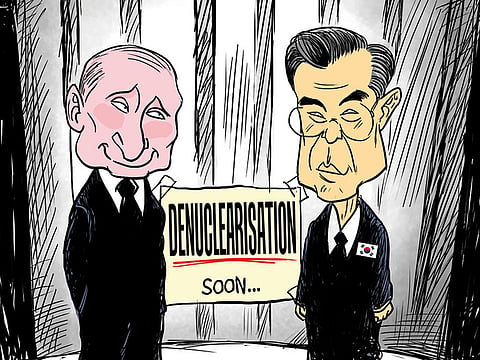Historic change in the air in Korean peninsula
Moon’s Russia trip and the wider grand diplomacy underline the swiftly shifting geopolitical tectonic plates in the region

Moon Jae-in finished up on Saturday his landmark trip to Russia, the first by a sitting South Korean President since 1999, after asserting that this month’s Singapore summit had ended the “Cold War”. Moon, who met with Russian President Vladimir Putin to discuss “denuclearisation” of the Korean peninsula, highlighted the historic change period potentially under way, urging “all parties to take a new path forward”.
This first visit by any South Korean head of state to Russia for around two decades underlines the shifting geopolitical tectonic plates around North and South Korea since the rapprochement between the two nations began this year. Last Monday saw the latest manifestation of this diplomatic warming with the decision to form some combined Korean sports teams to compete at this August’s Asian Games.
Following United States President Donald Trump’s Singapore session with North Korean leader Kim Jong-un, other major powers with a stake in the question of the future of the Korean peninsula, including Putin and Chinese President Xi Jinping, are all jockeying for position as the region’s military and strategic landscapes are potentially recast around the world’s last Cold War-era frontier.
One of the most spectacular features of this potentially extraordinary epoch, at least to date, has been the remarkable pivot of key powers towards greater engagement with the Pyongyang regime, while also seeking to enhance ties with Seoul, too. On the former issue, this was shown most markedly with Trump in Singapore, but is also true of Xi and Putin too, as all parties sense significant new political and economic opportunities opening up under future sanctions relief.
Here it is no coincidence that Xi recently invited Kim for three trips to Beijing (including the one last week), his first foreign tours since he assumed power in 2010, after Trump first announced in March about June’s Singapore summit. Moreover, Russian Foreign Minister Sergei Lavrov, who met Kim earlier this month in Pyongyang, has already invited the North Korean leader to visit Putin in Russia.
At the same time, Kim has been feted by Washington, Beijing and Moscow — the three have also been clear to consolidate ties with Moon. In May, Moon met Trump at the White House, while Xi also saw him that same month with Japanese Prime Minister Shinzo Abe for the first trilateral talks between the three nations since 2015.
Putin’s session with Moon was Russia’s latest attempt to enhance its own political and economic ties with Seoul. And it comes at a moment when Moon is promoting a “New Northern Policy” which, alongside peace talks with Kim, is a key foreign relations policy driver under which his administration is seeking to improve its ties with important Eurasian neighbours.
As part of these discussions to strengthen bilateral cooperation, Moon and Putin explored potential that may come from the decision of Kim and Moon to link roads and railways along the western and eastern corridors of the Korean peninsula. In coming years, these transport networks would be extended to China and Russia, opening up new opportunities into these important political and economic frontiers.
Kim’s trip was thus only the latest sign of the geopolitical flux in the region this year with hopes rising that North Korea is committed to a reform pathway. While that is by no means certain, given the uncertainty over the ambiguous pledges to “denuclearise” in the Singapore agreement week before last, the turnaround in spiralling tensions on the peninsula since late 2017 has nonetheless been as potentially important as it was unexpected.
Yet, while there are currently very positive atmospherics around the various diplomatic dialogues with Kim, all sides know there are significant downside risks as well as opportunities in play. This includes the possibility of tensions rising again on the peninsula in 2018 or beyond if the US-Koreas peace dialogue breaks down.
While Trump currently appears keen to have a sustained strategic dialogue with Kim, both of these two leaders’ personal and political volatility cannot be underestimated. And if Kim ultimately reneges on any key pledges in the US president’s eyes, the political pressure will be on Trump again to ratchet up his position against Pyongyang, despite the warm words of recent weeks.
Despite the successful diplomacy of recent weeks, Trump remains under political pressure in the US on this issue having drawn a political ‘red line’ as president over Pyongyang having nuclear weapons capable of striking the US homeland. And here he is well aware from last year’s missile tests that Kim now is close to developing a nuclear warhead capable of being fitted on to an intercontinental ballistic missile that can strike the US mainland.
Taken overall, Moon’s trip and the wider grand diplomacy on the peninsula involving Washington, Beijing and Moscow, following the Singapore summit, underlines that the geopolitical tectonic plates are speeding up in the Korean peninsula. However, while historic change could be in the air, significant downside risks remain if the North-South dialogue ultimately proves a mirage. The warming of relationships currently under way could yet go into reverse.
Andrew Hammond is an Associate at LSE IDEAS at the London School of Economics.
Sign up for the Daily Briefing
Get the latest news and updates straight to your inbox



